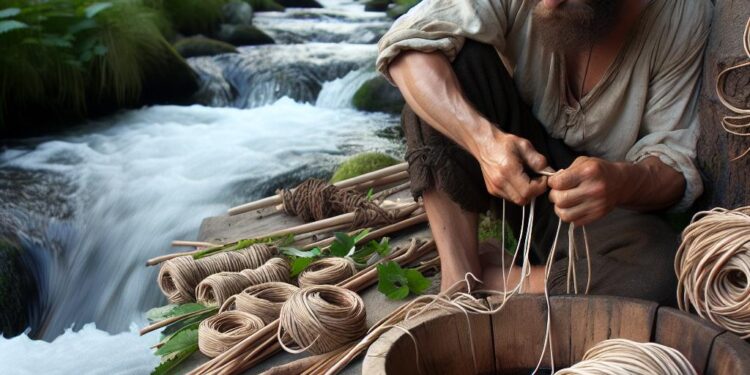Crafting rope from plants and bark is a fundamental skill in survival situations, offering incredible versatility when living off the grid. Whether it’s for building a shelter, setting traps, or securing gear, knowing how to make your own rope can be a game-changer during emergencies. Surprisingly, many overlook this skill or make the mistake of relying solely on modern ropes, missing out on a self-reliant technique that generations have honed. This blog will demystify plant and bark rope-making with step-by-step guidance and realistic solutions. At Survivor Daily, we’re committed to empowering you with practical skills for any situation.
What Is ‘Making Rope from Plants and Bark’?
Making rope from plants and bark is one of those survival skills that might sound old-fashioned, but it’s as practical as it gets when you’re out in the wild. Imagine you’re exploring remote trails or caught in an unexpected situation without a bit of rope. Well, learning to twist fibers from nature’s own supply can save the day. This skill is particularly handy in survival scenarios, whether crafting a shelter, securing gear, or even setting traps. Think of using long, sturdy strands of nettles or strips of willow bark intertwined together—a process that requires a bit of patience but pays off immensely. In the off-grid world, where trips to the shop are out of the question, this knack becomes a game-changer. Being able to create your own rope connects you to the resourcefulness of our ancestors, allowing you to thrive independently by simply harnessing what nature offers.Survival Benefits of Making Rope from Plants
When you’re out in the wild and your gear inventory doesn’t quite cut it, knowing how to make rope from plants and bark can be a significant advantage. Here are some key benefits:- Survival Readiness: Being able to make your own rope ensures you’re prepared for unexpected challenges, like securing gear or setting up a shelter, boosting your adaptability in nature.
- Safety and Security: A sturdy rope can be a lifesaver during risky situations such as climbing or crossing challenging terrains safely, offering peace of mind.
- Gear Efficiency: Instead of carrying multiple ropes, you can craft them on-the-go as needed, lightening your load and allowing room for other essential gear.
- Resourcefulness in Emergencies: In case of injury or need for a splint, homemade rope can be used to create makeshift braces or tie down bandages effectively.
- Environmental Sustainability: Utilizing natural resources like plants and bark minimizes your reliance on synthetic materials, promoting a more sustainable approach to outdoor living.
- Skill Mastery: Crafting rope from natural materials enhances your bushcraft skills, deepening your connection with the environment as you learn to use what’s naturally available.
- Reduced Reliance on Modern Systems: When modern tools and conveniences fail, having the knowledge of creating essentials like rope lets you thrive independently in the wilderness.
Crafting Rope from Nature for Everyday Use
- Practice making rope in your garden or local park using plant materials, such as grass or bark, to get hands-on experience without straying far from home.
- If living in an urban area, visit nearby wooded areas or nature reserves to locate materials and practice skills in a real-world setting.
- Incorporate your rope-making skills into hiking or camping trips by using the ropes for tying gear or building temporary structures.
- Set aside a weekend each month to learn and practice alongside family or friends, turning it into a fun and educational outdoor activity.
- Include plant-based rope making in your survival prep plan as a sustainable backup for modern synthetic ropes, increasing self-reliance during emergencies.
- Use tutorials and videos to continuously improve techniques and adapt to different environments, whether in the countryside or the city.
DIY Tips & Guided Use: Crafting Rope from Plants
- Choose flexible plants like nettles or willow for making rope. They’re found throughout the UK and easy to work with.
- Strip the bark from trees such as lime, willow, or birch for stronger fibers. Let it dry but don’t let it get too brittle.
- Twist the fibers together in a tight pattern for strength. Practice makes it easier!
- For expert guidance, consider survival courses if you’re planning an extended trip or are unsure about the quality of your cords.
– Campers would benefit from these quick techniques when needing to secure tents or gear.
– Solo travelers might use these to repair broken shoelaces or backpacks on the fly.
– Remote workers in nature can quickly rig up shelters or hang hammocks with homemade rope.
Making Rope: Quick & Cost-Effective Guide
Here’s a quick overview highlighting the costs and time involved in learning how to make rope from plants and bark.| Aspect | Cost/Time Effort |
|---|---|
| Gear Cost | Minimal to none, natural materials like plants and bark are often freely available in the wild. |
| Time to Learn | Several hours to a few days, depending on the complexity and practice needed. Beginners might spend more time initially. |
| Training Effort | Moderate. Involves understanding different plants, practicing knot-tying, and mastering twisting techniques for durable rope. |
| Setup Effort | Minimal. Gathering materials and preparing them can be done within an hour or two in a suitable environment. |
| Practical Use | Variable. Once learned, making rope can be done relatively efficiently in the field as needed. |




